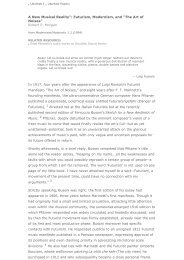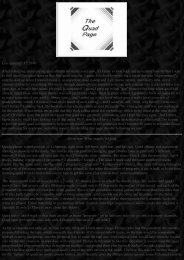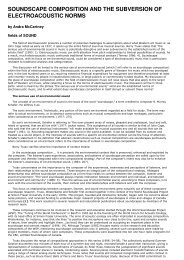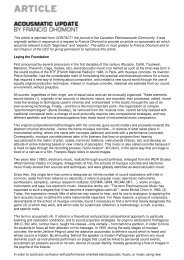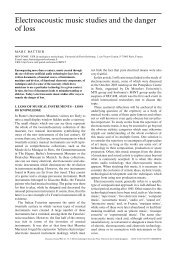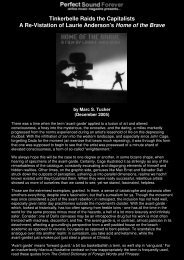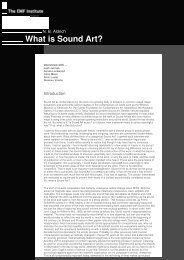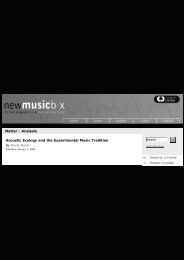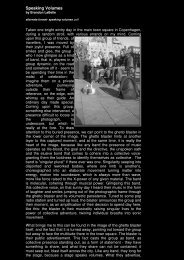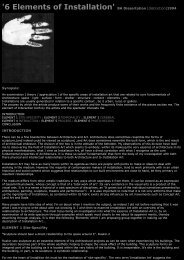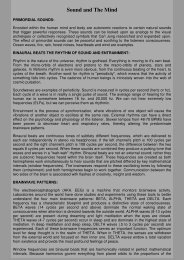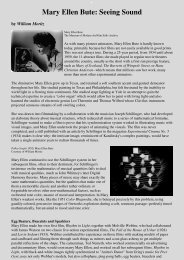Pierre Schaeffer "Solfege de l'objet Sonore" - An International ...
Pierre Schaeffer "Solfege de l'objet Sonore" - An International ...
Pierre Schaeffer "Solfege de l'objet Sonore" - An International ...
You also want an ePaper? Increase the reach of your titles
YUMPU automatically turns print PDFs into web optimized ePapers that Google loves.
UbuWeb |UbuWeb Papers<strong>Solfege</strong> <strong>de</strong> <strong>l'objet</strong> Sonore (1966)<strong>Pierre</strong> <strong>Schaeffer</strong>RELATED RESOURCES:<strong>Pierre</strong> <strong>Schaeffer</strong> in UbuWeb SoundIt is a well-established fact that our approach to music is generally twofold :this is the physicists' as well as the musicians' doing.One the one hand, music is consi<strong>de</strong>red to be based on acoustics, or evenmatheniatics, which ought to give it the status of a science; on the otherhand , it is acknowledged that it proceeds from psychological andsociological phenomena which, over the ages, have <strong>de</strong>veloped into an art,itself <strong>de</strong>pending on various crafts.There is no longer any contradiction between the two approaches so long asone is prepared to accept them jointly, with enough insight to respect themethods proper to each end of the "chain."Two initial problems, therefore, must be regar<strong>de</strong>d as equally fundamental :the first relates to the correlation between sound, which is the physicalvehicle of music and pertains to nature, and the sum of the psychologicalphenomena of perception which constitute the sound object : the secondrelates to the choice of efinite objects which are <strong>de</strong>emed suitable for musicby reason of their perceptive criteria, and leads to a sound morphology anda musical typology.There is, finally, a third problem: that of the value that such objects take onwithin a musical composition, and consequently of the nature of the music(or musics) which the choice of certain musical objects implies.It will be appreciated that these three problems belong to elementaryMusicology, which prece<strong>de</strong>s anv analysis of the musical i<strong>de</strong>as un<strong>de</strong>rlyingcomposition.Western music, "sophisticated" though it is supposed to be, seems to haveignored these distinctions up to now, and has been content with passing onthe age-old inheritance of "simple relationships" from generation togeneration. Linguistics has <strong>de</strong>veloped otherwise.This is subdivi<strong>de</strong>d into phonetics and honology, lexicology and syntax. Onemight then be tempted to draw a parrallerlwith acoustics and "acoulogy"(tonic solfa), musical theory and rules of composition. To do so would ineanmaking two rash or at least hinitative assumptions : not only that music isnothing more (or less) than a language, but also the one farniliar to thewestern world for the past few centuries.Music cannot be boiled down to a well-<strong>de</strong>fined language, nor can it thus beco<strong>de</strong>d merely by usage. Music is always in the making, groping its waythrough some frail and mysterious passage - and a very strange one it is -between nature and culture.Such high ambitions require some caution : many different stages andinfinite patience are involved.In our Treatise on Musical Objects, an attempt was ma<strong>de</strong> to synthesizethe three elementary problems as far as the "object" is concerned : theparticular difficulty of such an investigation, and also the peculiar fascinationwhich it holds, were stressed. One cannot, as in case of language, refer
solely to the existing texts. Sound still remains to be <strong>de</strong>ciphered, hence thei<strong>de</strong>a of an introduction to the sound object to train the ear to listen in a newway : this requires that the conventional listening habits imparted byeducation first be unlearned.The propositions contained in the Treatise on Musical Objects can,therefore, only be based on actual personal experience. For lack of textualreferences, which are still un<strong>de</strong>r research, or established quotations, it wasnecessarv to re- create the materials and the circumstances of an authentic"rnusical experience."Its purpose may then be manifold and those for whom it is inten<strong>de</strong>d many.Some are concerned with our first problern and look for proof of what isstated in the Treatise. This is precisely the purpose of the first part of thiscollection, which is <strong>de</strong>voted to relationships between acoustics and music.Others are engrossed in problems of composition. They will find in this samepart both the physical and physiological limits set down by nature and thekey to the distortions which occur between physical parameters andperception criteria. Furthermore, the second part will give them the meansfor drawing up an inventory of sound by providing a morphology and atypology.But evervone will finally have to admit that each one of us hears withdifferent ears sometimes too refined, sometimes too coarse, but in anyevent always "informed" by all kinds of prejudices and preconditioned byeducation. Ours is therefore ail extension of the rudiments of musical theorythrough a radical renovation of it.Whether one's interest lies in comprehension, in performing or ill listening, itis hoped that this work will contribute the basic elements of a musicalexperience. Confronting the i<strong>de</strong>as of a researcher with experimentalmaterials is not enough, one must sense musical communication : theharmony of a group united to give meaning to the aural material, as afunction of a listening intention.It is therefore, hardly necessary to add that, <strong>de</strong>cisive though the initiative ofthe present album's promoter and author may have been, its whole valuestems from the cooperation of the research team.To achieve such a work, several waves of researchers have succee<strong>de</strong>d eachother. Following the first discoveries of concrete music with <strong>Pierre</strong> Henrybetween 1948 and 1953, the subject was taken up again some years laterboth by experienced musicians such as lannis Xenakis and Ivo Malec and byyounger ones such as Luc Ferrari, Bernard Parmegiani, François Bayle andEdgardo Canton.But it is only over the past two years, simultaneously with the final drafts ofthe Treatise on Musical Objects, that a small team exclusively <strong>de</strong>voted toexperimental research was set up with Guy Reibel and Henri Chiarucci, andtheir assistant Beatriz Ferreyra. It is due to their combined efforts and to thecreation of the sound examples, for which Guy Reibel was responsible, thatan encounter was finall ma<strong>de</strong> possible between a systematic exposition andrelevant examples, to why the whole team has contributed at various times.Far more than the customary expression of thanks, this is theacknowledgment of a solidarity and a common <strong>de</strong>sire to be of assistance toothers : let me therefore <strong>de</strong>dicate this work collectively to all those whotake an interest in such work and in particular to the younger generation.Finally, it would be unfair to forget those who put the finishing touches tothese recordings and took part in their production and edition : my thanksto Jean-Louis Ducarme, Agnes Tanguy and to François Bayle, whosupervised the work.<strong>Pierre</strong> SCHAEFFER - 1966
top



